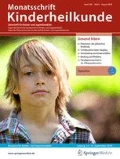Zusammenfassung
Das nephrotische Syndrom ist durch große Proteinurie sowie Hypalbuminämie definiert und stellt eine der häufigsten Nierenerkrankungen im Kindesalter dar. Die Unterteilung erfolgt nach den Kriterien: Ätiologie, Alter bei Erstmanifestation, Ansprechen auf Glukokortikoidgabe und histologische Befunde. Nach den Ursachen lässt sich das häufigere primäre nephrotische Syndrom von symptomatischen (sekundären) Formen im Rahmen anderer Grunderkrankungen abgrenzen. Sehr selten ist das kongenitale nephrotische Syndrom, das meist genetisch bedingt ist. Klinisch und prognostisch relevant ist in erster Linie das Ansprechen auf eine Glukokortikoidtherapie. Die primäre Steroidresistenz betrifft ca. 10% der Patienten mit idiopathischem nephrotischem Syndrom. Histologisch findet sich dann meist eine fokal-segmentale Glomerulosklerose, wohingegen bei steroidsensiblem nephrotischem Syndrom histologisch fast immer eine „Minimal-change“-Glomerulonephritis nachzuweisen ist. Im Fall häufiger Rezidive oder einer Steroidabhängigkeit sind zur Vermeidung von steroidassoziierten Nebenwirkungen alternative immunsuppressive Therapien z. B. mit Alkylanzien, Kalzineurininhibitoren oder Mykophenolsäure zu erwägen.
Abstract
Nephrotic syndrome is defined by severe proteinuria and hypoalbuminemia and is one of the most common renal diseases in the pediatric population. Nephrotic syndrome in children is classified by the criteria etiology, age at onset, response to glucocorticoids and histomorphology. Due to its etiology the common primary nephrotic syndrome has to be distinguished from secondary forms within the scope of other underlying diseases. The rare congenital forms have mostly a genetic background. Response to steroid therapy is highly relevant in terms of clinical course and prognosis. Primary steroid resistance affects about 10% of patients with idiopathic nephrotic syndrome. In these patients focal-segmental glomerulosclerosis is the leading histological finding, whereas in steroid-sensitive nephrotic syndrome minimal change glomerulonephritis is mostly found. In cases of frequent relapse or steroid dependency alternative immunosuppressive treatment options with e.g. cytostatic drugs, calcineurin inhibitors or mycophenolic acid should be considered to avoid steroid-associated side effects.




Literatur
Gipson DS, Massengill SF, Yao L et al (2009) Management of childhood onset nephrotic syndrome. Pediatrics 124:747–757
International Study of Kidney Disease in Children (1981) The primary nephrotic syndrome in children. Identification of patients with minimal change nephrotic syndrome from initial response to prednisone. J Pediatr 98:561–564
Lawrenz CE (2010) Inzidenzanalyse des nephrotischen Syndroms im Kindes- und Jugendalter in der Jahren 2005–2006, Inaugural-Dissertation, Rheinische Friedrich-Wilhelm-Universität Bonn. http://hss.ulb.uni-bonn.de/2010/2170/2170.pdf
Hinkes BG, Mucha B, Vlangos CN et al (2007) Nephrotic syndrome in the first year of life: two thirds of cases are caused by mutations in 4 genes (NPHS1, NPHS2, WT1, and LAMB2). Pediatrics 119:e907–e919
Heeringa SF, Chernin G, Chaki M et al (2011) COQ6 mutations in human patients produce nephrotic syndrome with sensorineural deafness. J Clin Invest 121:2013–2024
Benz MR (2011) Pipilotta und der Nierendetektiv, Familienschulung des nephrotischen Syndroms. Monatschr Kinderheilkd 159(Suppl 3):172
Citak A, Emre S, Sâirin A et al (2000) Hemostatic problems and thromboembolic complications in nephrotic children. Pediatr Nephrol 14:138–142
Brodehl J (1991) The treatment of minimal change nephrotic syndrome: lessons learned from multicentre co-operative studies. Eur J Pediatr 150:380–387
Schärer K (2002) Nephrotisches Syndrom. In: Schärer K, Mehls O (Hrsg) Pädiatrische Nephrologie. Springer, Berlin Heidelberg New York Tokio, S 205–227
Büscher AK, Kranz B, Büscher R et al (2010) Immunosuppression and renal outcome in congenital and pediatric steroid-resistant nephrotic syndrome. Clin J Am Soc Nephrol 5:2075–2084
Ehrich JH, Geerlings C, Zivicnjak M et al (2007) Steroid-resistant idiopathic childhood nephrosis: overdiagnosed and undertreated. Nephrol Dial Transplant 22:2183–2193
Plank C, Kalb V, Hinkes B et al (2008) Cyclosporin A is superior to cyclophosphamide in children with steroid-resistant nephrotic syndrome – a randomized controlled multicentre trial by the Arbeitsgemeinschaft für Pädiatrische Nephrologie. Pediatr Nephrol 23:1483–1493
Hoyer PF, Vester U, Becker JU (2008) Steroid-resistant nephrotic syndrome. In: Geary DF, Schaefer F (Hrsg) Comprehensive pediatric nephrology. Mosby Elsevier, Philadelphia, S 257–267
Arbeitsgemeinschaft für Pädiatrische Nephrologie (1987) Cyclophosphamide treatment of steroid dependent nephrotic syndrome: comparison of eight week with 12 week course. Arch Dis Child 62:1102–1106
Fujinaga S, Ohtomo Y, Hirano D et al (2009) Mycophenolate mofetil therapy for childhood-onset steroid dependent nephrotic syndrome after long-term cyclosporine: extended experience in a single center. Clin Nephrol 72:268–273
Kemper MJ, Gellermann J, Habbig S et al (2012) Long-term follow-up after rituximab for steroid-dependent idiopathic nephrotic syndrome. Nephrol Dial Transplant 27(5):1910–1915
Interessenkonflikt
Der korrespondierende Autor gibt für sich und seinen Koautor an, dass kein Interessenkonflikt besteht.
Author information
Authors and Affiliations
Corresponding author
Rights and permissions
About this article
Cite this article
Benz, M., Weber, L. Nephrotisches Syndrom im Kindesalter. Monatsschr Kinderheilkd 160, 787–804 (2012). https://doi.org/10.1007/s00112-012-2713-6
Published:
Issue Date:
DOI: https://doi.org/10.1007/s00112-012-2713-6
Schlüsselwörter
- Proteinurie
- Hypalbuminämie
- Glukokortikoide
- „Minimal-change“-Glomerulonephritis
- Fokale segmentale Glomerulosklerose

